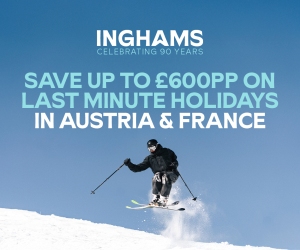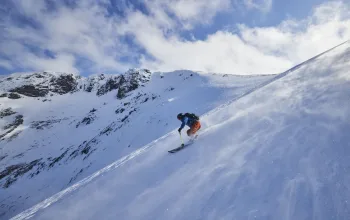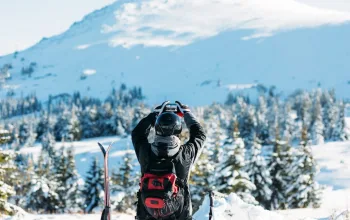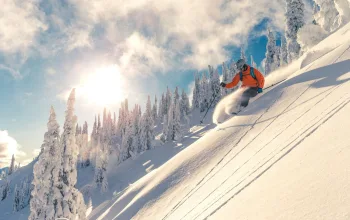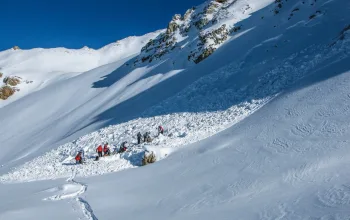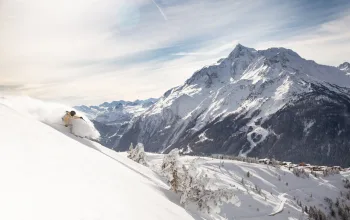Sponsored Content
Being a ‘beginner’ should be fun and exciting, but in order to get the most of your ski holiday, you must do your research. Many beginners worry about being cold. Skiing is an active sport, especially when learning and it’s unlikely you will feel the cold when on skis. But sitting still on a lift is another matter.
Get the gear
The most important factor is to wear the right clothing, especially next to your skin. A wicking’ material will ensure you are cool when working hard and warm when sitting still – avoid cotton and look for fabrics like merino wool and polypropylene. Being warm on the slopes is very important as a cold skier is an unhappy skier. There are manufacturers to fit all budgets but make sure that you do invest in a good base layer.
Boot fitting is not a ‘beginner’s’ nemesis, those who have skied for many a year still look to the professionals to fit their boots. Yes, they are generally a little uncomfortable for the first 10 minutes and yes, your thighs will burn, no matter how fit you think you are. This is all normal. You are human and even the pro’s get this. It is, however, very important to ensure you go to a reputable ski hire company. To be fitted properly and to make sure you are happy with the fit and feel.
Skis, again just take the advice from a good ski hire shop. Don’t think ‘better’ skis will make you a better skier. It’s about choosing what’s right for you.
Jargon busting
Skiing can be full of jargon, all of which can be bewildering to the first timer. Here’s a few of the more common terms demystified.
Grooming – piste bashers or snow cats are giant snow plough like machines whose lights can be seen twinkling on the mountain at night as they ‘groom’ the slopes – essentially flattening bumps and levelling the surface to make it easier for skiers the next day. Some resorts publish a ‘grooming’ list each day to show you where the best prepared slopes are.
Moguls - a ski term for bumps in the snow, caused by the pressure of turning skiers. Usually they form only on steeper slopes so are easy to avoid as a beginner.
Pistes – also called trails in North America or referred to as runs, this is just the common name for any single slope.
Find the way
Piste maps are not just pretty coloured squiggly lines – this ‘lingo’ you should learn:
Green: the easiest slopes on the mountain. Green pistes are normally wide and well groomed
Blue: intermediate pistes, again, well groomed
Red: intermediate piste – steeper and more difficult than blue but less so than black
Black: advanced, steep and a higher gradient. Sometimes these are groomed, sometimes not
Get prepared
For any beginner, make sure you book into ski school or if budget allows, private ski instructor. The professionals will take the time to work on your technique and encourage you to keep going. Don’t consider going it alone. Having an expert who knows the mountain can make for a great ski holiday. If you are travelling in school holidays ski schools can get booked up very quickly, so don’t leave it until you are in resort, book it before you go for peace of mind.
Before your first time on snow it makes a lot of sense to get to grips with the basics in the UK. Skiplex centres feature revolving ski slopes, a giant mirror to allow you to see your progress and small group instruction for really tailored advice on your technique. You may not get used to the cold or enjoy the spectacular views of being in the mountains but as an introduction to the feel of being on skis or a snowboard for the first time in a safe and controlled environment it’s the perfect choice. A course of 6 lessons will save you valuable time on snow and also get those ski muscles warmed up and ready to fire.
Choose the right resort
Choosing the perfect ski resort can depend on many things, but for beginners the following selection from the experts at Leo Trippi would all be a great choice.
Courchevel 1650: this resort has access to the ‘Three Valleys’ (the largest ski terrain in Europe) so once you get your snow feet, there is plenty of action to be found. But, until then, Courchevel 1650 has quiet slopes and the pistes are very well groomed.
Leo Trippi have some great catered ski chalets which are ski in/ ski out, making it easy for you to meet your ski instructor at the beginning of the day. A favourite is Chalet Marmotte which comes inclusive with a team of staff and the luxury of an outdoor Jacuzzi to ease those aching muscles at the end of the day.
Sainte Foy is perfect for families and beginners alike. It is very quiet and one of the smallest ski resorts in France. Stay in Chalet Rassel and you will have the service of your private chauffeur to connect you to surrounding resorts which make up the Espace Killy. The nursery slopes in Saint Foy are unthreatening and are a great choice for adult learners.
Meribel has something for everyone. It is perfect for beginners, especially the nursery runs towards the altiport which is a golf course in the summer. Here there is very little traffic and easy to access the blue slopes slightly higher up once you are ready. Chalet Chopine is not ski in ski out, but a favourite for a family ski holiday – of course, with any Leo Trippi holiday it comes fully catered with the bonus of a fantastic terrace overlooking the valley.




